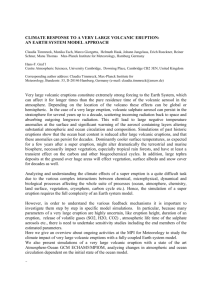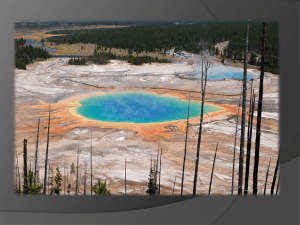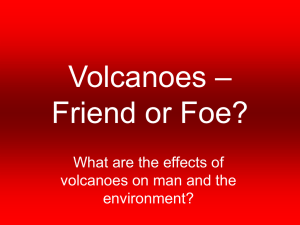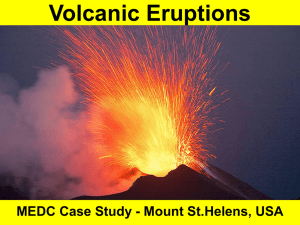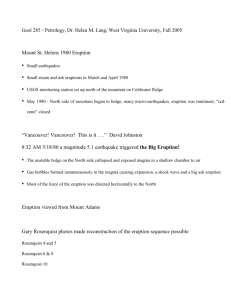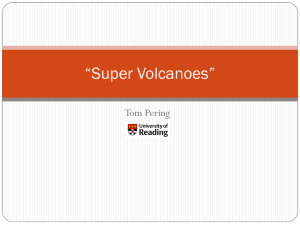Krakatau - WordPress.com
advertisement
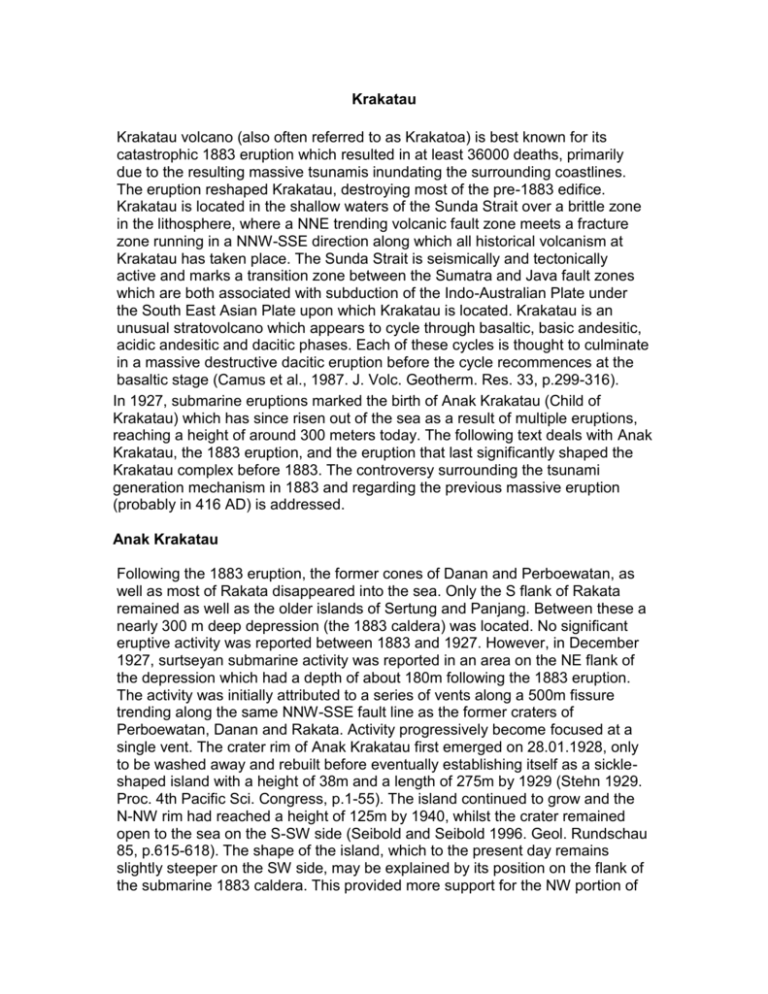
Krakatau Krakatau volcano (also often referred to as Krakatoa) is best known for its catastrophic 1883 eruption which resulted in at least 36000 deaths, primarily due to the resulting massive tsunamis inundating the surrounding coastlines. The eruption reshaped Krakatau, destroying most of the pre-1883 edifice. Krakatau is located in the shallow waters of the Sunda Strait over a brittle zone in the lithosphere, where a NNE trending volcanic fault zone meets a fracture zone running in a NNW-SSE direction along which all historical volcanism at Krakatau has taken place. The Sunda Strait is seismically and tectonically active and marks a transition zone between the Sumatra and Java fault zones which are both associated with subduction of the Indo-Australian Plate under the South East Asian Plate upon which Krakatau is located. Krakatau is an unusual stratovolcano which appears to cycle through basaltic, basic andesitic, acidic andesitic and dacitic phases. Each of these cycles is thought to culminate in a massive destructive dacitic eruption before the cycle recommences at the basaltic stage (Camus et al., 1987. J. Volc. Geotherm. Res. 33, p.299-316). In 1927, submarine eruptions marked the birth of Anak Krakatau (Child of Krakatau) which has since risen out of the sea as a result of multiple eruptions, reaching a height of around 300 meters today. The following text deals with Anak Krakatau, the 1883 eruption, and the eruption that last significantly shaped the Krakatau complex before 1883. The controversy surrounding the tsunami generation mechanism in 1883 and regarding the previous massive eruption (probably in 416 AD) is addressed. Anak Krakatau Following the 1883 eruption, the former cones of Danan and Perboewatan, as well as most of Rakata disappeared into the sea. Only the S flank of Rakata remained as well as the older islands of Sertung and Panjang. Between these a nearly 300 m deep depression (the 1883 caldera) was located. No significant eruptive activity was reported between 1883 and 1927. However, in December 1927, surtseyan submarine activity was reported in an area on the NE flank of the depression which had a depth of about 180m following the 1883 eruption. The activity was initially attributed to a series of vents along a 500m fissure trending along the same NNW-SSE fault line as the former craters of Perboewatan, Danan and Rakata. Activity progressively become focused at a single vent. The crater rim of Anak Krakatau first emerged on 28.01.1928, only to be washed away and rebuilt before eventually establishing itself as a sickleshaped island with a height of 38m and a length of 275m by 1929 (Stehn 1929. Proc. 4th Pacific Sci. Congress, p.1-55). The island continued to grow and the N-NW rim had reached a height of 125m by 1940, whilst the crater remained open to the sea on the S-SW side (Seibold and Seibold 1996. Geol. Rundschau 85, p.615-618). The shape of the island, which to the present day remains slightly steeper on the SW side, may be explained by its position on the flank of the submarine 1883 caldera. This provided more support for the NW portion of the island during its evolution. Eruptions of Anak Krakatau generally involve materials of basaltic or basic andesite composition. This suggests that their source is already slightly differentiated, suggesting that residual magma from the 1883 eruption may be involved or that unusually rapid differentiation of basaltic magmas from a deeper source has occurred. The upper magma chamber is located at a depth of about 9km based on S wave attenuation studies. This chamber is thought to have been sufficiently large to account for differentiation of the 1883 eruptates. A further larger chamber is thought to lie at a depth of 22km and beyond (Harjono et al., 1989. J. Volc. Geotherm. Res.39, p.335-348). Interestingly, the center of seismic activity below the edifice appears to rise and fall vertically from a depth of 100km to the surface. It has been suggested that it does this with a cycle length of about 30 years, corresponding to the 30 year intervals between recent peaks in activity (1927-30, 1958-63 and 1988 -93). Seismic monitoring over a longer period is necessary to confirm this hypothesis (Spicak et al., 2002. Stud. Geophys. Geod. 46, p.545-565). By 1959, the crater rim had reached a height of 152m, whilst the crater lake remained. The morphology of Anak Krakatau was significantly changed by the series of eruptions occurring in 1959-1963. These led to the emplacement of a new cone structure which was nested in the former crater and displaced the crater lake by 1960. Eruption sequences occurred on average every 3-4 years and typically lasting for about 6 months during the period from 1965 to 1988, building the new cone to a height of about 159m. During a phase of vulcanian activity in 1981, dacite bombs were erupted (62-63% SiO2), although this was unusual and did not mark the transition of the volcano into a new highly explosive dacitic phase of its long-term eruption cycle. The dacite eruption may have been the result of a residual pocket of differentiated lava from the 1883 eruption or a tiny pocket of freshly differentiated dacite at the top of the magma chamber. Anak Krakatau was particularly active in Nov. 1992 with the emplacement of two lava flows, one of which reached the sea to the NE, and between 1000 and 4000 strombolian explosions per day. Explosions continued and further lava flows (53.5% SiO2 - low Si basic andesite) were emplaced in Feb. and Apr. 1993 (Smithsonian BGVN 18:05). Several tourists were injured and one killed on the old crater rim by volcanic bomb impact on 13.06.93. By this time the new cone had reached a height of nearly 300m. Phases of minor strombolian activity were observed for much of the 1990s and up until 2002, when Anak Krakatau entered a rest phase with only sporadic discharges of gas. On 23 Oct. 2007, grey eruption plumes were observed rising from a vent to the SW of the central crater of Anak Krakatau. These marked the onset of a new phase of activity which climaxed in mid-late November with powerful strombolian (and possibly vulcanian) eruptions being reported. Activity paused in early 2008, yet by April the eruption had resumed again. The photos in this section are from a visit from 19.-23. May 2008. A lava flow had been emplaced on the SW flank about 10 days prior to this date. The crater is notably larger than it was in November and partial collapses of the wall separating it from the main crater could be observed. It is likely that the two craters will eventually merge if activity continues . Anak Krakatau is perilously perched on the flank of the 1883 caldera. It is possible that the main threat posed by Anak Krakatau at the present time could be the generation of tsumanis by failure of parts of the SW flank. It is suggested that a small such failure caused the 2m high tsunami experienced on Rakata during the night of 19-20 october 1981, when Krakatau once again started a new eruption sequence (Camus et al., 1987. J. Volc. Geotherm. Res. 33, p.299316). No collapse scar was noted so the event was presumably entirely submarine. For discussion of the generation of tsunamis by partial flank collapses, the reader is also referred to the sections on Stromboli and Augustine volcanoes. Much of the base of Anak must rest on a sloping layer of loose pyroclastic material from the 1883 eruption. Nevertheless, the SW flank is today supported by the flat bottom of the 1883 depression. Hence, a large-scale collapse seems unlikely. It should be mentioned that the islands of the Krakatau complex and particularly Anak Krakatau have provided a model system for numerous studies on the reintroduction of plant and animal life into an initially more or less "biologically sterile" environment. These studies will however not be discussed here. During eruptive phases, tourists are usually supposed to stay at a distance of 3km from the active cone and landings on Anak Krakatau are prohibited. These rules do not however appear to be strictly adhered to. Visitors should be aware of the risks associated with the type of activity commonly observed at the volcano as are illustrated in the photos below. The 1883 Eruption of Krakatau The appearance of Krakatau prior to the 1883 eruption is well documented. A relatively detailed map was made only 2 weeks prior to the catastrophic eruption by Captain Ferzenaar and correlated to previous sketches (M. Neumann van Padang "A Swedish Sketch of the Island of Krakatau in 1748"). The Island consisted of three adjoining cones, Rakata (800m), Danan (450m) and Perboewatan (120m) which had been constructed by a series of eruptions, the last recorded ones being in 1680-1681 and 1684, on the floor of the caldera formed during the last catastrophic eruption. The chronology of the 1883 eruption is based on eyewitness accounts from nearby coastal areas or ships, barometric data, tide gauge data and numerous subsequent geological studies. None of the eyewitnesses was close enough to directly observe the sequence of events at Krakatau during the final catastrophic phase of the eruption. Simkin and Fiske provide a detailed account of the climactic eruption ("Krakatau 1883: The Volcanic Eruption and its Effects", Smithsonian Inst. Press (1983)). On the 20th of May 1883 the awakening of Krakatau were first noted. Activity centered around Perboewatan cone and involved the explosive generation of several kilometer high ash clouds. This activity lasted for about a week after which it died down somewhat. On the 20th of July, violent explosive activity recommenced from new vents in the area between Perboewatan and Danan. The eruption gradually gained in intensity and on 11th of August eruptions were reported from at least 14 distinct vents, of which 3 were distinctly most active. The volcano entered into the penultimate Plinian eruption phase at 12:53 on 26. August. An incredibly powerful explosion marked the onset of this phase and created a cloud containing pumice and ash that reached an estimated height of 25km. The eruption gradually intensified and the ash column is thought to have been about 35km high by nightfall. At the same time, a transition from ash to pumice fall was observed in Telok Betong, 85km N of Krakatau. Nevertheless, little ash and pumice fall on land can be attributed to the eruption, possibly as the prevailing winds would have carried much of this material westwards out to sea. Tsunamis were recorded in Telok Betong harbour and hindered loading and unloading of ships. Localized pyroclastic flow activity due to intermittent partial column collapses can be attributed to this phase based on analysis of deposits on Rakata, Panjang and Sertung. The ultimate and most destructive part of the eruption involved a series of four tremendous explosions on the morning of 27. August. These occurred at approx. 5:30, 6:42, 8:20 and 10:02, with the last explosion having the highest intensity and propelling ash and pumice to an estimated height of over 40km. Whilst these explosions represented peaks in the eruption, the eruption was sustained by nearcontinuous explosive activity in the intervening periods. A fifth large explosion was reported at 10:52 and part of the wall of Rakata is thought to have subsided at 16:38. The largest explosions could be heard over 4500km away and thus probably represent the loudest sounds in historical times. The trigger mechanism for the eruption and in particular its most explosive phase may have involved the influx of fresh hot basaltic magma into the magma chamber. This could account for the rise in pressure therein. However, whilst small amounts of darker basaltic material can be seen in some of the erupted pumice, the levels observed are well below 5%. On the other hand, the suggestion that the eruptions were phreatomagmatic is not consistent with the fact that the subaerial eruption deposits lack extensive fragmentation and accretionary lapilli which would both be characteristic of phreatomagmatic activity (Self and Rampino, 1981. Nature 294, p.699-704). Further, sulphur and oxygen isotopic studies on tephra from the eruption suggest that degassing was open-system and occurred without significant involvement of seawater (Mandeville et al., 1998. Earth Planetary Sci. Lett. 160, p.709-722) Each of the massive eruptions was accompanied by large tsunamis. Whilst the final one was by far the largest, most coastal communities had already been severely damaged long before its arrival. The main tsunami reached Sebesi island (15km to the NW) first with an estimated height of 30m. Sebuku island, 30km to the NW was hit shortly afterwards, as was Lagoendi island, 40km to the N. The coastlines of Sumatra and Java adjoining the Sunda Strait at distances of at least 40 and 50km from Krakatau, respectively, were hit by tsunamis having estimated crest heights ranging from 15-35m and reaching run-up heights of about 15m on average. Observational inaccuracies and varying coastal topographies can account for the huge differences in reported wave heights. Analysis of the tsunamis is provided in e.g. Pararas-Carayannis 2003, Intl. J. Tsunami Soc. 21(4), p.191-221. The official death toll was over 36000 (including the whole population of 3000 on Sebesi and all inhabitants on the sparsely populated islands of Sebuku and Lagoendi), although many more may have perished. The source mechanism for the tsunamis is subject to debate. It is today widely considered that the emplacement of pyroclastic flows in the sea around Krakatau was intricately linked to the generation of the tsunamis. Pyroclastic flows and surges clearly played a major role in the eruption. Over 1000 lives were lost in the town of Ketimbang and nearby communities on the S coast of Sumatra (NW of Krakatau) as a result of burn injuries. Many more were injured. Accounts by Controller Beyerinck and his wife clearly describe how a hot pyroclastic surge inundated their hut on the slopes of Radja Bassa Volcano 400m above the town of Ketimbang, causing severe burns to those inside. This means that a pyroclastic surge travelled 40km across the sea in a predominantly NW direction whilst maintaining a high enough temperature to cause fatalities. The total extent of the surge was even greater, reaching a runout distance of at least 80km over the sea. This can be deduced by reports from the ships Loudon, Charles Bal and W.H. Besse which were located 65km NW, 65km NE and 80km NE of Krakatau, respectively. Each of these ships reported being showered with ash and later mud rain by sudden hurricane-force winds. The winds were strong enough to strip the Loudon of its sails and rigging. The surge was however no longer hot enough at these distances to cause fatalities. It is possible that hot parts of the surge also reached the coastline of Java. Both surge deposits and reports of burnt vegetation support this assumption. The pyroclastic surge and its deposits on the islands NW of Krakatau and the mainland is discussed extensively in Carey et al., 1996 (Bull. Volc. 57, p.493511). The high energy of the flows was probably associated with the collapse from a high eruption column. In its final stages, the eruption appears to have shifted from one with a convecting eruption column which occasionally collapsed to a dominantly collapsing column. This can be deduced from the layers of deposits left by the eruption on the Krakatau islands, which include up to 6m thick pyroclastic flow deposit units from the latter stages of the eruption (Self and Rampino, 1981. Nature 294, p.699-704). The largest explosion possibly propelled more material out of the volcano than any of the preceding ones, maybe as it occurred at the time of onset of caldera formation. Peak magma discharge is likely to be associated with caldera formation as the collapsing roof of the caldera may squeeze more magma out of the underlying chambers. The pyroclastic flow/surge speeds are estimated at anything from 130-320 km/h near source based on ability to mount topographical barriers, visual observations and arrival times at different points. Most of the trees on the islands of Sebesi and Sebuku were uprooted or snapped by the surge, including many on the 800m high summit. The ability of the surge to travel large distances over water is proposed to be the result of the production of a steam cushion by interaction of hot basal parts of the flow with the sea-water. This cushion would have not only reduced friction but also produced a barrier inhibiting the sedimentation of particles in the flow. The extent of the flows is not exactly known since no observations were reported W of the volcano. A minimum estimate of the area inundated by them is about 4000 square kilometers. The pyroclastic surges only represent the top, less dense, sections of pyroclastic flows that were emplaced in the sea during the climactic phase of the eruption. The emplacement of pyroclastic flow units in the sea around Krakatau has been analysed by correlating changes in bathymetry around Krakatau following the eruption with analysis of the composition of the deposits following the extraction of short cores therefrom (Mandeville et al., 1996. Bull. Volcanol. 57, p. 512-519). Interestingly, the pyroclastic flow deposits under water are similar in morphology to those on land. Mandeville had already shown that the submarine deposits were emplaced at temperatures of 475-550´C. This strongly suggests that little interaction between the core of the flow units and sea-water had taken place. Further, it is noted that the highest level of deposition was not immediately surrounding the vents but actually starts at a distance of a couple of kilometers therefrom. In fact, two new islands (named Stears and Calmeyer) were formed by deposits from the eruption several km NNW of Krakatau. These were however rapidly eroded by the sea and had disappeared 3 years later. Interestingly, one study calculated that the source of the tsunamis was near this position of high deposition, rather than at Krakatau itself (Latter 1981. Bull. Volcanologique 44(3), 468-490). It is concluded that the flows had sufficient energy to travel for significant distances across the sea surface before deceleration and increasing density at their base, due to gravitational segregation, resulted in a sinking of a high density component of the flow to the sea floor, whilst a lower density surge continued to flow across the sea surface. The sinking of the pyroclastic flows would have rapidly displaced a huge amount of water, and is today considered to be the most likely cause of the main tsunami(s). The PF deposits around Krakatau are extensive and occurred relatively concentrically around Krakatau, which suggests that the main eruption is unlikely to have been directed in a single direction. The total amount of ignimbritic (PF) deposits around Krakatau is estimated at over 20 cubic kilometers, most of which is found in a 15km radius of the vents. Taking this volume of deposits one can also see how much water must have been displaced by pyroclastic flows entering into the sea. Other theories have been proposed for the generation of the main tsunami. These are summarized in De Lange et al., 2001 (Natural Hazards 24, p.251266). The suggestion that a large scale phreatomagmatic explosion, or indeed a series of such explosions in relatively short succession, caused the main tsunami has been put forward by Yokoyama, largely based on analysis of pressure wave and tsunami arrival times (1981. J. Volc. Geotherm. Res. 34, p.123-132 and 1987. J. Volc. Geotherm. Res. 34, p.123-132). However, as already noted earlier, studies on the products of the eruption provide little evidence for extensive phreatomagmatic activity. It has also been suggested that the large-scale caldera collapse may have been the source mechanism for the tsunami. However, a subsidence of the sea floor should initially cause a drop in sea level. Nevertheless, the caldera collapse may have indirectly contributed to the tsunami by increasing the rate of magma output (Sigurdsson et al., 1991. Natl. Geogr. Res. Explor. 7, p.310-327) as has already been discussed in the main model. A further theory is that the tsunami was caused by a NW-directed lateral blast (Camus et al., 1992. Geo Journal 28, p.123-128). The Mt St Helens eruption of 1980 showed that a lateral blast and associated debris flow could displace a significant body of water i.e. spirit lake. Further, the changed bathymetry to the NW was considered reminiscent of the hummocky deposits at Mt St Helens. However, as already discussed, significant deposits are not only found to the NW and the deposits do not appear to contain many lithic fragments (i.e. fragments of the edifice) as would be expected in the case of a lateral blast. Further, one may expect a debris flow to be most dense near source, which is not the case at Krakatau. Nevertheless, it is conceivable that a highly energetic debris avalanche may be able to "skim across" the sea surface for some distance. Certainly the eruptions were powerful enough to destroy significant parts of the edifice, since Perboewatan crater which lay N of the 1883 caldera perimeter must have been removed by explosive activity. Nevertheless it appears that there is presently little evidence which corroborates the lateral blast theory. The eruption subsided rapidly after the main explosive event. Most reports of activity in the following weeks and months could be discounted. After the eruption, a sizeable portion of Rakata appears to have remained at the SE rim of the caldera. Large rockfalls were reported 2 weeks after the eruption, 9 months later and again in 1896 and 1897 (Simkin and Fiske, 1983 "Krakatau 1883: The Volcanic Eruption and its Effects", Smithsonian Inst. Press (1983)) and are likely to have further contributed to the present shape of Rakata island with its NW oriented cliff-face, from which eruptions of Anak Krakatau can today often be heard echoing. The eruption produced copious amounts of pumice which was deposited on the sea surface in large rafts. These were meter-thick in places and hindered shipping for the next weeks. Most of Krakatau had been removed and the remaining islands were covered in a series of 2-6m thick pyroclastic deposit layers, reaching a total thickness of up to 60m (Mandeville et al., 1996. Bull. Volc. Vol.57, p512-529). The total erupted volume is estimated at 10-15 cubic km of dense rock equivalent (DRE). The eruption belched so much ash and sulfur dioxide into the atmosphere that it had a global climatic impact, resulting for example in a small drop in average temperature in the Northern Hemisphere the following year. The caldera formed during the 1883 eruption has been subjected to extensive bathymetric and gravimetric analysis (Deplus et al., (1995). Journal Volc. Geotherm. Res. Vol.64, p.23-52). A large flat-bottomed 240m deep depression is found to the SW of Anak Krakatau. Earlier measurements by Escher in 1919 had recorded a depth of up to 280m and noted a small 20m high N-S oriented ridge in the centre of the depression. It can be assumed that remobilized materials and eruptates from Anak Krakatau, which is perched on the NE flank of the depression in an area previously recorded as having a depth of over 180m, account for the gradual filling of the depression. The caldera has a diameter of approx. 4km, yet the depression extends in the form of a narrow graben about 2km to the E and 1km to the SW. This may mark the location of fault lines underlying the complex. Looking at gravimetric data which can distinguish materials of different density (the low density pyroclastic eruptates have little gravitational significance), it was calculated that a funnel shaped hole having a depth of over 1km is located in the bedrock at the center of the depression. The hole has been largely filled by relatively light recent pyroclastic material and older fragments of the pre-1883 edifice. Krakatau before 1883 (Ancient Krakatau) The Islands of Sertung, Panjang and the base of Rakata are considered to mark the boundaries of a large submarine caldera with an approx. diameter of nearly 8km (Deplus et al., 1995). This caldera is thought to be the result of an earlier eruption of similar magnitude to the 1883 event. Based on an excerpt from the Pustaka Raja (Javanese Book of Kings), the eruption was initially dated to 416 AD. Here it is suggested that a volcano (probably Krakatau) erupted violently and burst apart before sinking into the sea. The sea rose and inundated the land and Java and Sumatra were divided into two parts. The accuracy of this account is however disputed since there is no corroborating scientific evidence for a large eruption at this date and the link between an eruption of Krakatau and the separation of Java and Sumatra is questionable. Nevertheless, the account of the eruption bears striking similarity to the eruption of 1883 since it appears to describe a violent, ultimately caldera-forming, eruption associated with tsunamis. Tree-ring and ice-core data suggest that a major volcanic eruption with global climatic impact occurred in 535 AD. Keys and Wohletz (Wohletz 2000, Los Alamos National Laboratory, LA-UR 00-4608) propose that a massive eruption of Krakatau took place at this date and argue (taking the account of the division of Java and Sumatra by the eruption literally) that the Sunda Straits are actually the resulting huge, about 50km diameter, caldera. Present-day Krakatau is located on the SW border of this proposed caldera. Whilst the correction of the dating from 416 AD to 535 AD is based on scientific studies, little general support is found for their massive caldera hypothesis. In fact, the Sunda Strait is generally attributed to the clockwise plate-tectonic rotation of Sumatra relative to Java (Nishimura et al., 1992. GeoJournal 28, p.87-98). Based on data obtained from the analysis of drill-holes in the sediments surrounding Krakatau, Ninkovich suggested a completely different date for the major eruption shaping the pre-1883 caldera (Ninkovich, 1979. J. Volc. Geotherm. Res. 5, p.67-86). However, his estimation that the eruption occurred 60000 years ago is not widely accepted. Following the 416(/535)AD eruption, historical records appear to suggest eruptions around 850, 950, 1050, 1150, 1320 and 1530 although no accurate record exists of the date or type of eruption. The 1680-1681 and 1684 events were at least partially documented by dutch mariners and appeared to have centered around Perboewatan cone. Both involved explosive activity and the former involved emplacement of lava flows (Smithsonian GVP - Eruptive History Krakatau). Krakatau, Indonesia Locatrion and plate tectonic Indonesia contains over 130 active volcanoes, more than any other country on earth. They comprise the axis of the Indonesian island arc system, which is generated by northeastward subduction of the Indo-Australian plate. The great majority of these volcanoes lie along the topographic crest of the arc's two largest islands - Java and Sumatra. The islands are separated by the Sunda Straits, which is located at a distinct bend in axis of the island arc volcanoes, from a nearly east-west orientation in Java to a northwest-southeast orientation in Sumatra. Krakatau is one of a several volcanic islands in the Sunda Straits located above an active north-northeast trending fault zone, an orientation quite distinct from the main island-arc trend. Although relatively small when compared to the largest volcanoes along the island arc, Krakatau and its associated volcanoes have shown the capacity to generate highly explosive eruptions. PHYSIOGRAPHY BEFORE AND AFTER THE 1883 ERUPTION The pre-eruption island of Kratatau was composed of three coalsced volcanoes aligned along a north-northwest direction, parallel to the volcanoes on Sumatra. From north to south, these were Perboewatan, Danan, and Rakata. During the eruption, Perboewatan, Danan, and the northern half of Rakata appear to have collapsed into the vacating magma chamber, thus forming a submarine caldera and destroying the northern two-thirds of the island. Some workers, however, have argued for an alternative to the caldron-collapse model, and instead have suggested that the caldera formed by explosive destruction of the island, and the reaming out of the pre-eruption edifice. Eruptions since 1927 have built a new cone called Anak Krakatau ("child of Krakatau") in the center of the 1883 caldera. THE CATACLYSMIC EVENTS OF AUGUST 26-27 After reawakening on May 20, 1883, Krakatau generated mild detonations from Perboewatan throughout May and June. By mid-June the summit crater of Perboewatan had been largely destroyed and the cite of eruption widened to include several new vents near Danan. By mid-July, banks of pumice were common features found floating in the Sunda Straits. However, some of the earliest tephra was basaltic, indicating that recharge of basalt magmas into the magma chamber beneath Krakatau may well have played a role in the intiation of these early eruptions. Sunday, August 26. At 12:53 p.m., Krakatau delivered the opening salvo to a climactic eruption that would last throughout the evening of August 27. The initial blast generated an ear-shattering fusillade accompanied by a black churning cloud of volcanic debris that rose quickly to 25 km above the island. Over the next several hours, it would widen dramatically to the northeast, rising to a height of at least 36 km. The intensity of the eruptions increased throughout Sunday, frightening the coastal communities of western Sumatra, western Java, and adjacent islands. Later in the day, these villages would be battered by a series of devasting tsunamis generated by pyroclastic flows plunging into the sea. The worst was yet to come. Monday, August 27. This frightening display of volcanic power would culminate in a series of at least four stupendous eruptions that began at 5:30 a.m., climaxing in a colossal blast that literally blew Krakatau apart. The noise was heard over 4600 km away, throughout the Indian Ocean, from Rodriguez Island and Sri Lanka in the west, to Australia in the east. Two-thirds of the island collapsed beneath the sea into the underlying, partially vacated magma chamber. About 23 square kilometers of the island, including all of Perboewatan and Danan, subsided into a caldera about 6 km across. At an original height of 450 m, Danan had collapsed to depth of 250 m below sealevel. ENORMOUS SEA WAVES The cataclysmic blasts of August 27 generated mountainous tsunamis, up to 40 m tall, that ravaged coastlines across the Sunda Straits. Many of the closest islands were completely submerged. After first being overwhelmed by massive pyroclastic flows (see below), Sebesi Island northeast of Krakatau, was innudated by mammoth sea waves. These tsunami stripped away all vegetation, washed ~3000 people out to sea, and destroyed all signs of human occupation. Although located at seemingly safe distance, 80 km east of the Sunda Straits, the low-lying Thousand Islands were buried by at least 2 m of seawater and their inhabitants had to save themselves by climbing trees. Eyewitness accounts of the massive waves came from passengers of the Loudon, who survived the barrage only through the heroic efforts of its Captain Lindemann. The ship was anchored in Lampong Bay, near the village of Telok Betong when the first of several waves arrived on Monday morning: PYROCLASTIC AIRFALL AND DEVASTING PYROCLASTIC FLOWS Tsunamis were clearly responsible for most of the fatalities at Krakatau. However, ~4,500 deaths (over 10% of the total) have been attributed to falling tephra and hot pyroclastic flows. The amount of tephra generated is thought to be about 20 cubic kilometers, or twenty times that of the destructive Mt. St. Helens eruption in 1980. Near Sumatra, the Sunda Straits were clogged with so much debris that it looked like solid ground. Relief ships were unable to reach coastal communities like Telok Betong for weeks. Over the ensuing months, storms and high-tides would disperse thick banks of floating pumice beyond the Straits, into the Java Sea and Indian Ocean. Ships thousands of kilometers from Krakatau would report huge fields of this floating debris for months after the eruption. One such accumulation floated 8,170 km, until it reached Durban, South Aftica in September, 1884. About 2000 of the corpses in southern Sumatra had severe burns, indicating that they had been scorched to death, peresumably from pyroclastic flows. Although the behavior of pyroclastic flows and surges over water is poorly contrained by direct observations, the evidence suggests that they can travel great distances over open water. One compeling feature of the Krakatau eruption is that the pyroclastic flows appear to have travelled an incredible 40 km across the Sunda Straits, where they remained hot enough to cause the burn-related fatalities on Sumatra. These same flows, however, were also recorded by several ships located at greater distances. On August 27, the Louden (see above) was located ~65 km north-northeast of Krakatau when it was struck by severe winds and tephra, and the W.H. Besse was located at ~80 km east-northeast of Krakatau when it was hit by hurricane-force winds, heavy tephra, and the strong smell of sulfur. At these greater distances, the pyroclastic flows were at lower temperatures so that the ships and crew survived. How is it possible for pyroclastic flows to travel such great distances? Pyroclastic flows are hot mixtures of solid particles and expanding volcanic gases. While advancing over water, the base of the flow will conert the water to steam. The rapid expansion of water to vapor greatly enhances flow fluidization and inhibits the deposition of particles, particularly the low-density pumiceous particles, thus allowing the flow to travel tens of kilometers over flat oceanic waters. This mobility was first recognized during the 1902 eruption of a pyroclastic flow from Mt. Pelée, which destroyed the coastal city of St. Pierre, only to continue across open waters to overturn and burn ships anchored several kilometers offshore. After travelling 40 km over the Sunda Straits, pyroclastic flows struck southern Sumatra with a vengence, remaining hot enough to incinerate entire villages and burn all vegetation before loosing impetus on the highly forested mountainsides. The wife of Controller Beyerinck from the Sumatra village of Ketimbang described her expereince on the morning of August 27, when the outermost edges of a pyroclastic flow enveloped her family and their acquantainces, killing some and sparing others: ATMOSPHERIC EFFECTS Tephra from the eruption fell as far as 2,500 km downwind in the days following the eruption. However, the finest fragments were propelled high into the stratosphere, spreading outward as a broad cloud across the entire equatorial belt in only two weeks. These particles would remain suspended in the atmosphere for years, propogating farther to the north and south before finally dissipating. The stratospheric cloud of dust also contained large volumes of sulfur dioxide gas emitted from Krakatau. These gas molecules rapidly combined with water vapor to generate sulfuric acid droplets in the high atmosphere. The resulting veil of acidic areosols and volcanic dust provided an atmospheric shield capable of reflected enough sunlight to cause global temperatures to drop by several degrees. This aerosol-rich veil also generated spectacular optical effects over 70% of the earth's surface. For several years after the 1883 eruption, the earth experienced exotic colors in the sky, halos around the sun and moon, and a spectacular array of anomalous sunsets and sunrises. Artists were fascinated by these aerial displays and captured them on canvas. The painting shown here is one such sunset captured by the artitst William Ascroft on the banks of the River Thames in London, on November 26, 1883 (Courtesy of Peter Francis). AFTERMATH: the Child of Krakatau On December 29, 1927, a group of Javanese fisherman who were startled by steam and debris bleching from the sea above the collapsed caldera, thus marking the reawakening of Krakatau after 44 years of calm. The activity continued, and on January 26, 1928 the rim of a basaltic scoria cone first appeared above sealevel. A year later, it had grown into a small island which was quickly dubbed Anak ("Child of") Krakatau. Anak Krakatau has erupted in most years since. Typically, these are rather mild strombolian to vulcanian eruptions of basaltic andesite lava flows and associated tephra deposits. Although they present little danger to surrounding islands, the eruptions from Anak Krakatau provide a constant reminder of the horror of 1883 Lest we forget.
